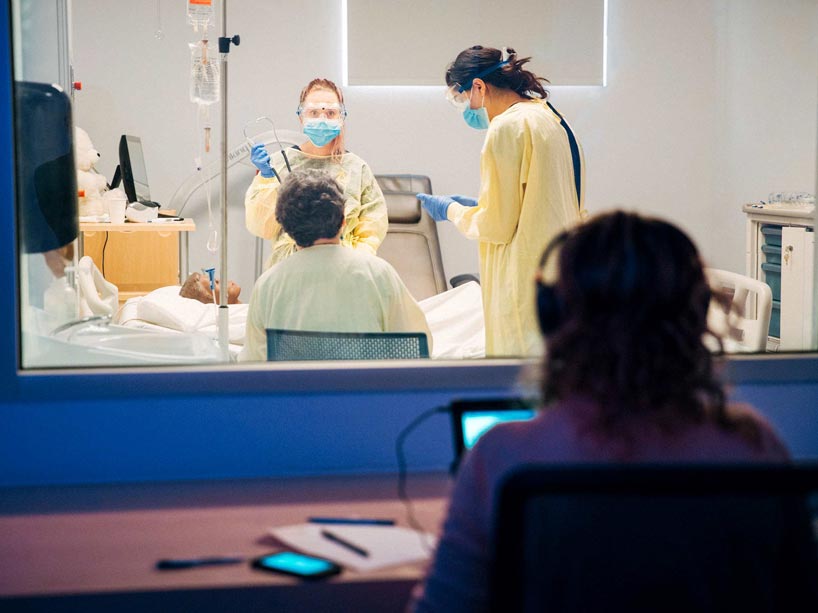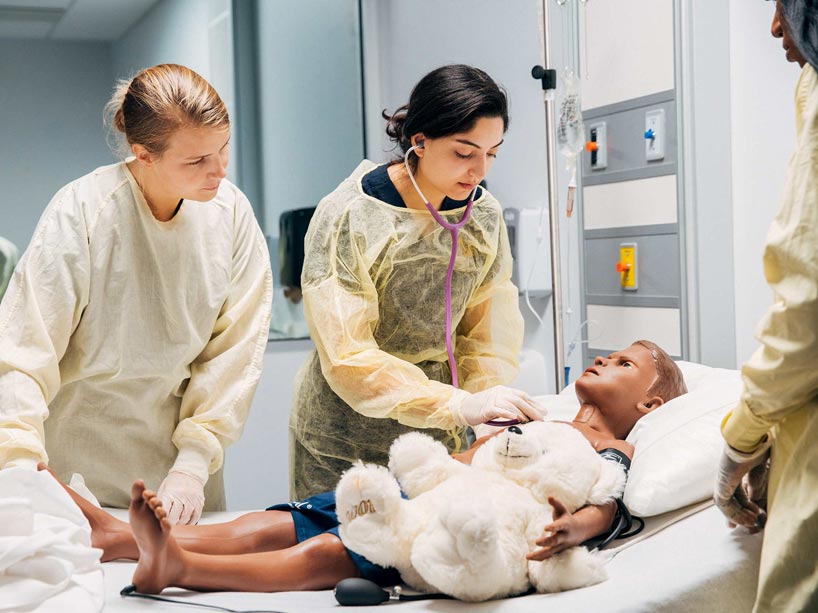New state-of-the-art nursing simulation lab increases capacity for learning

Suites in the new nursing lab are equipped for an operator/lab instructor to control the simulation patient – everything from heart rate, breathing, etc. The operator can speak as the patient to the students, giving them insight on how the patient is feeling. Photos by Ryan Walker.
When the Daphne Cockwell Health Sciences Complex opened earlier this year, with it opened a high-tech simulation lab for Ryerson’s School of Nursing. The lab, located on the fourth floor in the university’s newest building, was built to replicate hospital wards with three large 15-bed wards and individual rooms, as well as supply and linen closets. Look a little further, though, and you’ll find a genuine space where students have access to state-of-the-art technology that gives them practical experience before they even hit the workforce.
Here, nursing students have access to clinical suites where they can practice interactions with patients, in-depth clinical examinations, and nursing-station equipment set up to simulate real-life conditions and hospital scenarios.
Ryerson’s Daphne Cockwell School of Nursing (DCSN), the largest nursing school in Ontario, received a gift of just over $1 million from the FDC Foundation to improve their existing simulation equipment and match their new facilities.
Nancy Walton, director of the school of nursing, was quick to acknowledge the impact that such a gift has on the capacity to learn. “We’re always looking for ways to incorporate more simulation into clinical learning,” she said. “This lab and this new equipment allows us to do it even better.”
Improved nursing simulation experiences
In addition to replicating a real hospital setting, the new simulation suites can be adapted to accommodate several different settings, like out in the community or in the home. “The sky is the limit,” said Walton, “you can arrange the suites to replicate any of the possible environments where nurses are providing care.”
The FDC Foundation gift allowed the DCSN to acquire the best and most relevant patient simulation mannequins and debrief software systems, which lab technicians operate from control rooms attached to the suites.
“The mannequins can talk and respond. If you shine a light in their eye, for example, they can be made to turn their head,” said Walton.
Scenarios are videotaped and students can debrief after the simulation activities.

Students work with high-tech mannequins that talk, move and respond to light. This helps improve patient care and confidence.
Live actor simulations have also become more real in the lab’s new setting. These simulations give students exposure to experiences like potential abuse and suicidality in a safe space.
“Live actor simulations are very compelling for students. They become so engaged that they can forget they are working with actors,” said Walton. Experiences like this are valuable for students to build confidence and coping strategies to face challenging situations in future work environments.
Multi-perspective gamification
The DCSN, widely known for their award-winning virtual gaming simulations, will utilize part of the FDC Foundation gift to develop more gamification tools. Walton hopes, that as a leader in this space, the school and programs can offer both students and other users multi-perspective scenarios with future games.
The DCSN plans to develop seven games over the next three to four years. One way they will expand is to explore presenting clinical situations in the gaming scenarios from more than one perspective. For example, learners will have the opportunity to appreciate a clinical situation from the views of all involved, like the nurse, patient and caregivers.
“The reality that people are living longer with more chronic conditions is affecting the context of providing nursing care. In any environment our students are practicing, they are essentially always looking after older adults.”
DCSN’s virtual gaming simulations are open access - so accessible to anyone. Walton noted that there are plans for gaming to be even better incorporated into revised curriculums for both the collaborative and post-diploma nursing programs over the coming years, not just in practice courses.
“There is no end to the complexity of humans. Virtual gaming allows us to build in the complexity that nurses experience, in a way that students can take in piece by piece. This gives them the chance to apply it to their real-life experience in the professional world,” said Walton.